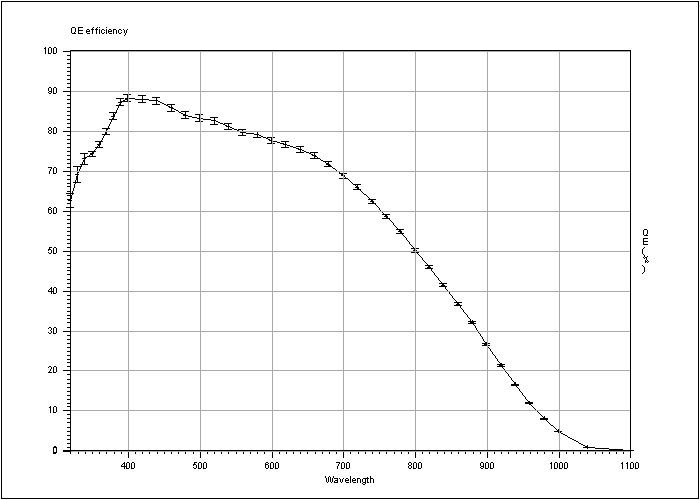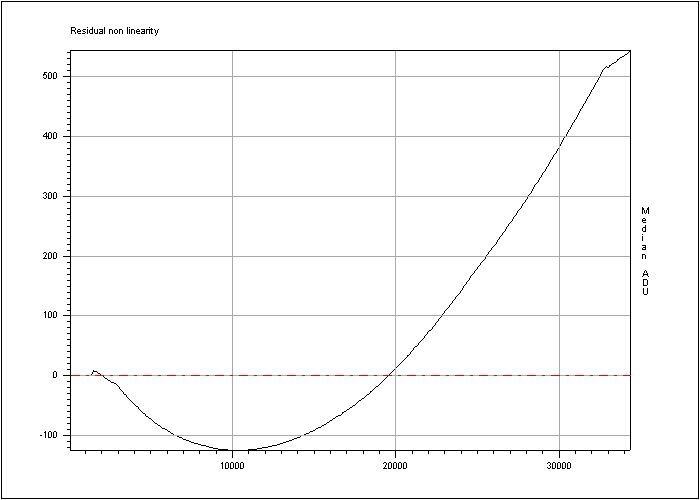
Measurement made by Boris Gaillard the: 07-15 June 2001
Data
reduced by Fabrice Christen the: 27 June 2001
Clock mode: 225kpx/rr/HG/512 Conversion Factor= 1.177e-/ADU ±0.00332 for 13691.9ADU RMS noise = 7.2013e- ±0.1487 CCD temperature : -120.0Cº Window area is : X1= 2210 X2= 4232 Y1= 8 Y2= 502 Bandwidth 5nm Wav. QE% PRNU rms% Phase= 320 62.5 ±1.8 7.47 8.107697 330 69.1 ±2 7.26 8.07588 340 72.9 ±1.4 7.15 8.059834 350 74.1 ±0.73 7.12 8.056765 360 76.5 ±0.76 7.07 8.052922 370 79.8 ±0.79 6.52 7.970918 380 83.6 ±0.83 5.01 7.708336 390 87.1 ±0.89 3.76 7.426375 400 88 ±0.89 2.96 7.195299 420 87.9 ±0.89 2.07 6.84974 440 87.5 ±0.88 1.6 6.603393 460 64.5 ±0.65 1.35 6.438478 480 83.8 ±0.84 1.24 6.359287 500 83.1 ±0.83 1.17 6.300414 520 82.4 ±0.83 1.1 6.234828 540 81 ±0.82 1.05 6.192784 560 79.6 ±0.79 1.02 6.160523 580 78.9 ±0.79 1.01 6.16034 600 77.6 ±0.77 0.989 6.13718 620 76.6 ±0.75 0.976 6.123978 640 75.3 ±0.73 0.982 6.131029 660 73.7 ±0.71 0.84 5.970883 680 71.6 ±0.68 0.823 5.952052 700 68.7 ±0.64 0.888 6.026818 720 65.8 ±0.6 0.957 6.101561 740 62.3 ±0.57 1.04 6.179947 760 58.5 ±0.52 1.08 6.206456 780 54.7 ±0.48 1.12 6.251885 800 50 ±0.43 1.27 6.384276 820 45.9 ±0.39 1.17 6.301537 840 41.4 ±0.35 1.22 6.336483 860 36.6 ±0.31 1.15 6.278702 880 31.9 ±0.26 1.46 6.476734 900 26.5 ±0.21 1.6 6.615499 920 21.3 ±0.17 2.91 7.198289 940 16.5 ±0.13 4.04 7.472676 960 11.8 ±0.09 4.95 7.606612 980 7.88 ±0.06 6.24 7.878669 1000 4.67 ±0.035 7.45 7.985302 1040 0.782 ±0.0058 7.37 8.044858 1100 0.096 ±0.00071 8.85 8.315915
Table 1: Measurement of the Quantum Efficiency.
Figure 1: Graphic representation of the QE.
Figure 2: Graphic representation of the PRNU.
In this section you can compare the QE we measured with the testbench and:
QE Minimum specification
Typical QE
QE from Marconi
|
|
|
|---|---|
Figure 3: Comparison between the QE measured by ESO, the QE measured by Marconi, ESO specification and minimum specification. |
Figure 4: Ratio between the ESO measurements and the ESO minimum specification. |
|
Special specification |
|||
|
Wavelength(nm) |
Minimum spec. (%) |
ESO measurements (%) |
Result |
|
350 |
50 |
78.69 |
OK |
|
400 |
80 |
87.64 |
OK |
|
650 |
80 |
73.3 |
Under the minimum spec. |
|
900 |
25 |
26.47 |
OK |
|
Conclusion: |
No, this CCD is not in the 25 %. |
||
Table 2: Minimum specification for 25 % of the CCDs.
|
Comparison QE ESO / QE Marconi |
|||||
|
Wavelength (nm) |
QE ESO (%) |
QE Marconi (%) |
Difference (Eso - Marc. %) |
Relative difference (Marconi as reference %) |
Ratio QE ESO / QE Marconi |
|
350 |
78.69 |
64 |
14.69 |
22.9 |
1.23 |
|
400 |
87.64 |
83.6 |
4.04 |
4.8 |
1.05 |
|
500 |
81.91 |
81 |
0.91 |
1.1 |
1.01 |
|
650 |
73.3 |
73.4 |
-0.1 |
-0.2 |
1.00 |
|
900 |
26.47 |
26.5 |
-0.03 |
-0.1 |
1.00 |
Table 3: Difference and relative difference between ESO measurements and Marconi.
|
|
|
|---|---|
Figure 6: Graphic representation of the difference and the relative difference. |
Figure 7: Ratio between the ESO measurements and the Marconi measurements |
In this section you can compare the PRNU we measured at ESO and:
PRNU Minimum specification
PRNU from Marconi
|
|
|
|---|---|
|
Figure 8: Comparison between the PRNU measured by ESO, the PRNU measured by Marconi, and the maximum specification. |
Figure 9: Ratio between the ESO measurements and the Maximum specification. |
|
|
|
|
Figure 10: Graphic representation of the difference and the relative difference. |
Figure 11: Ratio between the ESO measurements and the Marconi measurements. |
|
Comparison QE ESO and QE Marconi |
||||||
|
Wavelength (nm) |
PRNU ESO (rms %) |
Maximum spec. |
PRNU Marconi |
Difference (Marc – ESO) |
Relative difference (Marc. as reference) |
Ratio PRNU ESO / PRNU Marconi |
|
320 |
7.47 |
6 |
/ |
/ |
/ |
/ |
|
350 |
7.12 |
5 |
5.8 |
-1.32 |
22.76 |
1.23 |
|
400 |
2.96 |
2.5 |
2.3 |
-0.66 |
28.7 |
1.29 |
|
500 |
1.17 |
2 |
1 |
-0.17 |
17 |
1.17 |
Table 4: Difference and relative difference between ESO measurements and Marconi.
In this section you will see the if the values we have measured for the QE and the PRNU are in accordance with the contract.
|
Wavelength (nm) |
Qe |
PRNU |
|
320 |
OK |
Outside the maximum specification |
|
340 |
OK |
|
|
350 |
OK |
Outside the maximum specification |
|
360 |
OK |
|
|
380 |
OK |
|
|
400 |
OK |
Outside the maximum specification |
|
450 |
OK |
OK |
|
500 |
Below the minimum specification |
OK |
|
550 |
Below the minimum specification |
|
|
600 |
Below the minimum specification |
|
|
650 |
Below the minimum specification |
|
|
700 |
OK |
|
|
750 |
OK |
|
|
800 |
OK |
|
|
850 |
OK |
|
|
900 |
OK |
|
|
950 |
Below the minimum specification |
|
|
1000 |
Below the minimum specification |
|
Table 5: Comparison between the values we have measured and the specifications in the contract.
For the flat field we use three wavelengths, 350nm, 600nm and 900nm. For each wavelength we make two images, high level (45000 ADU) and low level (1000 ADU).
350nm (UV), bandwidth 5nm |
600nm, bandwidth 5nm |
900nm, bandwidth 5nm |
|||
High level |
Low level |
High level |
Low level |
High level |
Low level |
Table 6: Flat field for three wavelengths.
Remark: Strange pattern at 350nm.
The time exposure, for the long dark exposure, is 3600 seconds.
Table 7: Bias and dark.
Remark: As you can see on the dark image we have on this CCD some electroluminescence (two white spots below).
Clock mode: 225kpx/rlrl/HG/512 Left readout port Conversion Factor= 0.60093e-/ADU ±0.002338 for 20402.2ADU RMS noise = 3.9704e- ±0.212 Right readout port Conversion Factor= 0.59636e-/ADU ±0.003876 for 20694.1ADU RMS noise = 7.0509e- ±0.5928 Clock mode: 50kpx/rlrl/HG/512 Left readout port Conversion Factor= 0.58016e-/ADU ±0.0022 for 20439.4ADU RMS noise = 2.6985e- ±0.1145 Right readout port Conversion Factor= 0.57271e-/ADU ±0.001877 for 20805.5ADU RMS noise = 3.1529e- ±0.1362
RMS non linearity (%) = 1.1 Peak to peak non linearity (%)= 3.3

Figure 12: Error of linearity

Figure 13: Residual non linearity.
Exposure time (s) = 3600 Dark current : 2.95 ± 0.03 ADU/hour/pixel Dark current : 1.63 ± 0.02 e-/hour/pixel
High level (Around 25000 ADU) Horizontal CTE = 0.999998 Vertical CTE = 0.9999991
In this section we expose the hot pixel, the dark pixel, the trap and the very large trap we found.
A hot pixel provides a signal of > 60 e- / pixel / hour.
Result: 114 hot points.
a very bright pixel provides a signal of > 200000 e-/pixel/hour
A dark pixel is one with 50% or less than the average output for uniform intensity light level, measured with a flat field level around 500 photo-electrons.
Result: 331 dark pixels detected.
A trap is defined as a pixel that captures more than 10 electrons, measured with a flat field level around 500 photo-electrons.
Result: 16 trap
A very large trap is defined as a pixel that captures more than 10 000 electrons, measured with a flat field level around 90% of full well capability.
Result: / very large trap.
A bad column is 10 or more contiguous hot or dark pixels in a single column or a very bright pixel or a very large trap.
Result: 1 bad columns.
Here is a summary of cosmetic defects:
|
|
Hot pixel |
Dark pixel |
A very bright pixel (a) |
Trap |
Very large trap (b) |
Sup. 10 contiguous pixels (c) |
Total bad column (a+b+c) |
|---|---|---|---|---|---|---|---|
|
ESO |
114 |
331 |
/ |
16 |
/ |
1 |
1 |
|
Marconi |
417 |
6 |
3 |
1 |
0 |
7 |
|
Table 8: Summary of cosmetic defects.
Be careful, in the ESO test report we didn't include the very large trap in the total bad column because for this CCD we couldn't measure this parameter.
Back to the overview page ESO Test Reports for the OmegaCAM CCDs